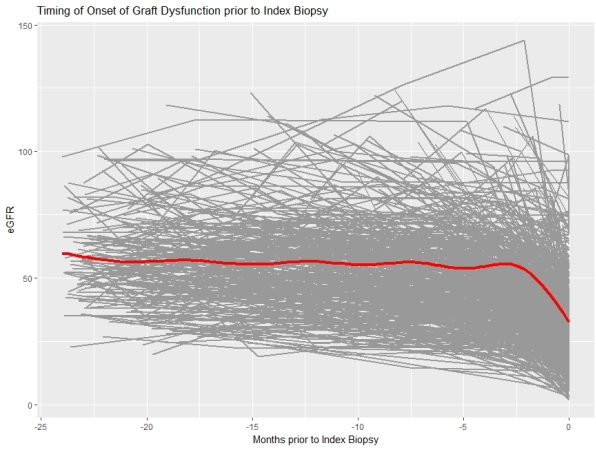Death-Censored Graft Failure (DCGF) Post Kidney Transplant (KTx) is Usually the Result of Rapid Loss of Function after Periods of Stability
1CTI Clinical Trial & Consulting, Covington, KY
2Int. Med., U Iowa, Iowa City, IA
3Biostatistics and Surgery, U Minnesota, Minneapolis, MN.
Meeting: 2018 American Transplant Congress
Abstract number: D94
Keywords: Graft survival, Kidney transplantation, Multicenter studies, Renal injury
Session Information
Session Name: Poster Session D: Kidney Complications: Late Graft Failure
Session Type: Poster Session
Date: Tuesday, June 5, 2018
Session Time: 6:00pm-7:00pm
 Presentation Time: 6:00pm-7:00pm
Presentation Time: 6:00pm-7:00pm
Location: Hall 4EF
Late graft dysfunction leading to clinically indicated transplant biopsy (KTxBx) is a better predictor of subsequent DCGF than baseline data and early post-transplant events (Gaston et al, AJT 2017). A perception persists, however, that DCGF is usually the result of progressive slow KTx damage, “creeping creatinine.” We examined this hypothesis in the DeKaf Prospective Cohort (PC) by examining the evolution of estimated glomerular filtration rate (eGFR) over time following baseline at 3 months after KTx up to the time of a first clinically indicated KTxBx.
Methods: The DeKaf PC consisted of 3,774 new KTx recipients; of these, 3, 678 had graft survival for >3 months post KTx. eGFR from serum creatinine (CKDEpi formula) was assessed at 3 months baseline and again at month 6 and every six months post KTx thereafter for up to 7 years. 694 of these patients subsequently underwent clinically indicated KTxBx a median of 15 months post KTx (Range: 3 – 89 months) for reasons other than BK or recurrent disease, forming the subjects of this report. Line graphs of eGFR over time for each KTxBx from up to two years prior to the biopsy and at or after the 3 month baseline until the time of KTxBx were constructed and plotted on one set of axes, using the ggplot function of the R package ggplot2. A smoothed average of eGFR values at times prior to transplant was plotted using the geom_smooth function.
Results: While there was considerable variability of the trajectories of the individual Tx eGFRs, on average the eGFR remained quite stable until about 2 – 3 months before the clinical presentation leading to KTxBx.
Conclusions: In most cases, patients ultimately undergoing KTxBx more than 3 months following KTx have quite stable eGFR for long periods prior to developing abrupt renal dysfunction 2 – 3 months before clinical presentation. To assure early diagnosis and treatment of episodes of renal injury, renal function should be assessed at least every 2 – 3 months, even years following KTx.
CITATION INFORMATION: Gaston R., Hunsicker L., Fieberg A., Matas A., The DeKaf Consortium Death-Censored Graft Failure (DCGF) Post Kidney Transplant (KTx) is Usually the Result of Rapid Loss of Function after Periods of Stability Am J Transplant. 2017;17 (suppl 3).
To cite this abstract in AMA style:
Gaston R, Hunsicker L, Fieberg A, Matas A, Consortium TheDeKaf. Death-Censored Graft Failure (DCGF) Post Kidney Transplant (KTx) is Usually the Result of Rapid Loss of Function after Periods of Stability [abstract]. https://atcmeetingabstracts.com/abstract/death-censored-graft-failure-dcgf-post-kidney-transplant-ktx-is-usually-the-result-of-rapid-loss-of-function-after-periods-of-stability/. Accessed December 18, 2025.« Back to 2018 American Transplant Congress

